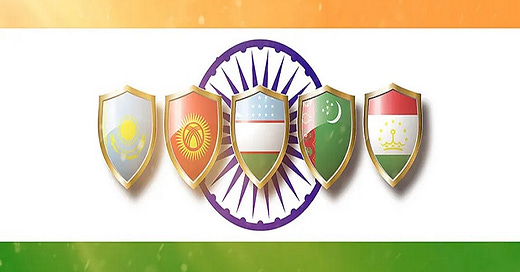This route complements their existing efforts to preemptively diversify from potentially disproportionate dependence on any given trade partner and thus helps them maximally ensure their strategic autonomy.
Indian National Security Advisor (NSA) Ajit Doval announced during the second Indian-Central Asian NSA meeting in Kazakhstan that his country’s five partners all plan to join its North-South Transport Corridor (NTSC) through Iran. This is no small matter since it shows that the Central Asian Republics (CARs) are relying on India (and by extension Iran) to optimize their balancing acts. To be clear, this is purely pragmatic and doesn’t imply ill intent against any third parties, but it’s still a notable observation.
From the CARs’ perspective, no opportunity to diversify their access to the global economy should be passed up since disproportionate dependence on any given trade partner (or pair thereof in the Sino-Russo Entente’s case) is considered a risk to their strategic autonomy. This even includes some of their neighbors as proven by the newly created Southern Transport Corridor between Russia and the region via the Caspian Sea, which safeguards against possible Kazakh treachery stemming from its pro-EU pivot.
The most prominent example up until this point, however, has been the Middle Corridor between China and Turkiye via Central Asia, the Caspian, and the South Caucasus, which has the potential to streamline the CARs’ connectivity with the EU too (whether via Turkiye-Balkans or via the Black Sea from Georgia). The NSTC completes the region’s “geo-economic compass” by incorporating a southern vector that complements these countries’ traditional northern one with Russia and the aforesaid east-west vector.
The Pakistan-Afghanistan-Uzbekistan (PAKAFUZ) railway had the potential to fulfill this role instead of the comparatively longer NSTC but failed to do so due to the Pakistani-Taliban security dilemma that emerged after the US’ withdrawal and especially following Pakistan’s post-modern coup in April 2022. The end result was that the NSTC became the only viable southern-directed route for the CARs to access the global economy, hence why they all just reaffirmed their desire this week to utilize that corridor.
The timing couldn’t have been more fortuitous from India’s standpoint since it coincided with the third Belt & Road Initiative (BRI) Forum in Beijing, which is also celebrating the 10th anniversary of this global series of megaprojects. The Western media sought to exploit the optics of this event to push their narrative that the previously globalized economy is bifurcating into Western- and Chinese-led blocs, but that claim is rubbished by the growing appeal of India’s NSTC, which Russia participates in alongside Iran.
India objects to BRI on the basis that this global initiative’s flagship China-Pakistan Economic Corridor (CPEC) transits through Pakistani-controlled disputed territory that Delhi claims as its own, which is why Prime Minister Modi decided not to attend this week’s event nor any related ones prior to that. Some among the Alt-Media Community (AMC) had earlier claimed that India would suffer from its refusal to participate in BRI, yet the NSTC’s expansion to the CARs discredits that claim too.
It’s also important to mention that President Putin referenced the NSTC during his speech in Beijing as an example of Russia’s efforts to accelerate Eurasian integration, which highlights this megaproject’s grand strategic significance and also suggests that the AMC’s fears about India’s intentions are misplaced. Some top influencers have either fallen for the false narrative that India is the West’s “Trojan Horse” or know that it’s untrue but still launder it to generate clout, push an ideology, and/or solicit donations.
In any case, they’ve either deliberately or unwittingly manipulated their audience’s perceptions about that country’s geostrategic role, which is why it’s so significant that the CARs all agreed to join India’s NSTC the same week as China’s latest BRI Forum in which President Putin referenced that megaproject. This route complements their existing efforts to preemptively diversify from potentially disproportionate dependence on any given trade partner and thus helps them maximally ensure their strategic autonomy.




